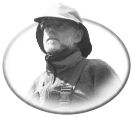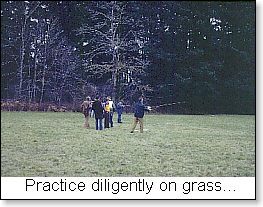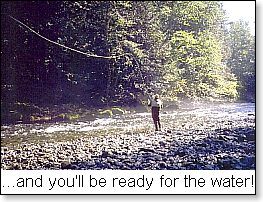
Improve
Your Fly Casting
by Peter
Caverhill
( Laying out
a Plan for the New Year )
Wouldn't
it be terrible to live in a climate and area where fly fishing opportunities
abounded the whole year round? There would be no "off-season"
in which to regroup one's energies or to reflect on the successes and
failures of the previous year. We'd be without valuable down time to prepare
for those new adventures that are waiting for us a few months ahead. Interior
lakes are frozen and, on the coast, the last of the chum
salmon are finning aimless circles, waiting to die. (At risk of creating
covetedness among the interiorites, we won't dwell on the fact that we
coasters do have year long fly flinging opportunities. Sometimes on nice
winter days, it's hard to choose between time astream, a round of golf,
or an excursion in the sailboat.) It's sufficient to say that, even on
the coast, winteris a time when most of us choose to be fireside warm
rather than frozen to some streamside boulder. So now, when there is some
spare time away froma whole lot of nifty fishing temptations, is really
the time to lay out and execute some plans for improvement. What better
objective than to work on our flycasting?!
 WHY
BOTHER ? WHY
BOTHER ?
"Why
bother now?" "There will be lots of opportunity during fishing
season to practise and improve" "I'm quite happy with my casting
and I catch fish, so why get worked up about fly casting anyway?".....Hmmm??
Here's the sales pitch for the improvement plan. Fly casting is the foundation
or essence of fly fishing. If you can't deliver the fly properly to the
fish, you are seriously disadvantaged. Fly casting is a fairly complex
process and therefore requires some serious attention. The caster needs
to be able to use limb and body movements to present a light lure (the
fly) using a heavy line and a special tool (the fly rod) to a variety
of quarry under many different physical, climatic and even emotional conditions.
The improvement side of the process is something that never ends. Happily
there is no such thing as achieving perfection, only the interesting challenge
of a continual search for it. The poetry and beauty of fly casting is
what sets fly fishing apart from other forms of angling (just look how
the movie "A River Runs Through It" has influenced many to take
up the sport). Better casting will reduce fishing frustration, be more
personally satisfying and ..... you'll sure be able to show off more effectively!
When you are out fishing is just about the worst time to concentrate on
fly casting improvement. There are just too many variables that will prevent
total focus on the elements of casting. Think of these interferences :-wind,
bushes in front and behind, cold fingers, up to the waist in water, mosquitoes,
difficult to see exactly what the line is doing and how the cast has really
performed. To make matters worse, those pesky fish will likely even interfere
from time to time!

THE FLY CASTING
IMPROVEMENT PLAN
The "off-season"
plan is really pretty simple. All you need is to decide that improvement
will be beneficial, and then commit some timeto the exercise. Here are
the plan aspects:-
 Advice
and assistance - There is a wealth of information available on flycasting
in the form of videos, books and magazine articles. If you bang your computer
hard enough there may even be on-line places with fly casting advice.
Seek out material by some of the gurus of fly casting instruction: Mel
Kreiger, Lefty Kreh, Gary Borger, Joan Wulff, Doug Swisher, BillyPate,
Al Kyte, Tom White, Mike and Denise Maxwell and others. Most
of these people have both written and video material. They all have tons
of years of instructional experience and there own "style"of
explaining and teaching. The key elements of what it takes to make good
fly casting is common to them all, even though their explanations and
choice of words make them appear to be different. The videos are a great
way to go! Most are well done, with easy to see casting actions interspersed
with on-the-water examples of how a casting lesson should work in real
fishing. Often an instructor will have several videos (introductory as
well as advanced casting) and possibly a book to back up the videos. Books
and magazine articles are a useful way to study the techniques in depth
(via the written descriptions and diagrams) and provide an easily accessible
reference when required. Fly fishing mags frequently provide casting articles.
These are worth clipping/copying in order to create an additional source
of casting reference material in a ring binder. Search out back copies
of the mags in second hand book stores. The local fly shop should have
(or can get) the various books and videos on casting. Most shops will
rent the videos. So commandeer the TV this winter and run through a variety
of these videos. You surely won't feel like it when the trout are gorging
on mayfly duns under a brushy bank and behind the big rock - just when
you'll need the casting skills that you could have acquired in the slow
season. Advice
and assistance - There is a wealth of information available on flycasting
in the form of videos, books and magazine articles. If you bang your computer
hard enough there may even be on-line places with fly casting advice.
Seek out material by some of the gurus of fly casting instruction: Mel
Kreiger, Lefty Kreh, Gary Borger, Joan Wulff, Doug Swisher, BillyPate,
Al Kyte, Tom White, Mike and Denise Maxwell and others. Most
of these people have both written and video material. They all have tons
of years of instructional experience and there own "style"of
explaining and teaching. The key elements of what it takes to make good
fly casting is common to them all, even though their explanations and
choice of words make them appear to be different. The videos are a great
way to go! Most are well done, with easy to see casting actions interspersed
with on-the-water examples of how a casting lesson should work in real
fishing. Often an instructor will have several videos (introductory as
well as advanced casting) and possibly a book to back up the videos. Books
and magazine articles are a useful way to study the techniques in depth
(via the written descriptions and diagrams) and provide an easily accessible
reference when required. Fly fishing mags frequently provide casting articles.
These are worth clipping/copying in order to create an additional source
of casting reference material in a ring binder. Search out back copies
of the mags in second hand book stores. The local fly shop should have
(or can get) the various books and videos on casting. Most shops will
rent the videos. So commandeer the TV this winter and run through a variety
of these videos. You surely won't feel like it when the trout are gorging
on mayfly duns under a brushy bank and behind the big rock - just when
you'll need the casting skills that you could have acquired in the slow
season.
There is
nothing wrong with renting a fly casting instructor for an houror so.
Skiers, tennis players, golfers and bowlers do it in order to get by the
painful early stages of learning , to acquire more sophisticated techniques,
or to iron out problems. For some reason, we fly fishers are often reluctant
to seek out professional help and to spend a few dollars (remember this
fly fishing may be a life-long condition, so why be afflictedwith unhappy
casting skills?). Once again, the local fly shop is the place to ask about
casting instructors. The Federation of Fly Fishers (FFF) has a program
to "certify" fly casting instructors and, increasingly, instructors
with these qualifications will be available. Certification helps to assure
students that they are getting an instructor who has the skills to teach
others (this doesn't imply that those without credentials can not be effective
teachers).


Practice,
practice, practice - Even though it's cold and miserable out there,
you should want to seek out your local soggy piece of schoolyard lawn
or snowpatch, and flog away. All that video and book research should have
you quivering for perfection. So what if your neighbours are able to confirm
the mental instability they always believed you suffered from! The best
way to practice fly casting is to do it on terra firma (grass or areasonable
facsimile). If you choose your site well, there will be no interference
from brush, wind, or stray cats. The dry land stuff allows you to cast
against a measured distance (try a line marked off in 5 foot intervals);
to setout targets for accuracy practice, and to walk out your cast to
see how it fared (did it really straighten out or did the last 10 feet
of a 70 foot cast land in a pile?). Under controlled conditions, you will
be able to practice the various casts, correct them, and repeat them many
times. This process of locking-in the correct way, between eye body and
brain, is essentially what practice is really for. You may have to repeat
the correct move many thousands of times until it becomes instinctive.
Gear check
- there is no sense in trying to achieve better flycasting if your rod,
line and leader are not in balance. These days, it's much harder to purchase
an unbalanced outfit, as manufacturers provide excellent tools throughout
their price range, and shops dispense good gear advice. However, if your
gear is of uncertain origin and balance, take it to a shopor an experienced
fly caster for advice. The ideal set-up for practice is a medium weight
outfit (line weight #5 to #7). Use a brightly coloured floating fly line
and a 9 foot tapered leader to which is tied a small piece of bright yarn
(don't use any part of a real fly for practice as this is dangerous for
bystanders who may want to sue you for a lost eye!). The bright fly line
is essential for you to better see how your casting is behaving.
THE GUTS
OF GOOD FLY CASTING - ALWAYS KEEP THIS IN MIND
As part of
the "fly casting improvement plan" I will leave you with some
"truths" to ponder on as you work your way to better casting.
Your job will be to search out any additional details that might be needed
to better understand and appreciate their validity. I like to think of
these 5 truths or essential elements as the "guts" of good fly
casting . They are described in a small booklet published by the FFF (The
Essentials of Fly casting - by Bill and Jay Gammel -1993) :-
- There
must be a pause at the end of both the front and back portion of the
casting stroke, which varies in duration with the amount of line beyond
the rod tip (ie. more line = longer pause).
- Slack
line, during the casting process, must be kept to an absolute minimum.
- The rod
tip must move in a straight line path during the casting stroke.
- The stroke
length (or size of the casting arc) must vary with the length of line
past the rod tip.
- Power
must be applied in the proper amount and in the proper place in the
casting stroke.
(casting
stroke = the entire motion that the casting arm goes througto create a
back cast and a forward cast )
Keep these
5 elements in sight, watch videos and read, practice awafrom fishing,
and you will improve the quality of your fly casting, no matter how much
experience you have.
Peter's
Arcticles...
|




 WHY
BOTHER ?
WHY
BOTHER ?
 Advice
and assistance - There is a wealth of information available on flycasting
in the form of videos, books and magazine articles. If you bang your computer
hard enough there may even be on-line places with fly casting advice.
Seek out material by some of the gurus of fly casting instruction: Mel
Kreiger, Lefty Kreh, Gary Borger, Joan Wulff, Doug Swisher, BillyPate,
Al Kyte, Tom White, Mike and Denise Maxwell and others. Most
of these people have both written and video material. They all have tons
of years of instructional experience and there own "style"of
explaining and teaching. The key elements of what it takes to make good
fly casting is common to them all, even though their explanations and
choice of words make them appear to be different. The videos are a great
way to go! Most are well done, with easy to see casting actions interspersed
with on-the-water examples of how a casting lesson should work in real
fishing. Often an instructor will have several videos (introductory as
well as advanced casting) and possibly a book to back up the videos. Books
and magazine articles are a useful way to study the techniques in depth
(via the written descriptions and diagrams) and provide an easily accessible
reference when required. Fly fishing mags frequently provide casting articles.
These are worth clipping/copying in order to create an additional source
of casting reference material in a ring binder. Search out back copies
of the mags in second hand book stores. The local fly shop should have
(or can get) the various books and videos on casting. Most shops will
rent the videos. So commandeer the TV this winter and run through a variety
of these videos. You surely won't feel like it when the trout are gorging
on mayfly duns under a brushy bank and behind the big rock - just when
you'll need the casting skills that you could have acquired in the slow
season.
Advice
and assistance - There is a wealth of information available on flycasting
in the form of videos, books and magazine articles. If you bang your computer
hard enough there may even be on-line places with fly casting advice.
Seek out material by some of the gurus of fly casting instruction: Mel
Kreiger, Lefty Kreh, Gary Borger, Joan Wulff, Doug Swisher, BillyPate,
Al Kyte, Tom White, Mike and Denise Maxwell and others. Most
of these people have both written and video material. They all have tons
of years of instructional experience and there own "style"of
explaining and teaching. The key elements of what it takes to make good
fly casting is common to them all, even though their explanations and
choice of words make them appear to be different. The videos are a great
way to go! Most are well done, with easy to see casting actions interspersed
with on-the-water examples of how a casting lesson should work in real
fishing. Often an instructor will have several videos (introductory as
well as advanced casting) and possibly a book to back up the videos. Books
and magazine articles are a useful way to study the techniques in depth
(via the written descriptions and diagrams) and provide an easily accessible
reference when required. Fly fishing mags frequently provide casting articles.
These are worth clipping/copying in order to create an additional source
of casting reference material in a ring binder. Search out back copies
of the mags in second hand book stores. The local fly shop should have
(or can get) the various books and videos on casting. Most shops will
rent the videos. So commandeer the TV this winter and run through a variety
of these videos. You surely won't feel like it when the trout are gorging
on mayfly duns under a brushy bank and behind the big rock - just when
you'll need the casting skills that you could have acquired in the slow
season.